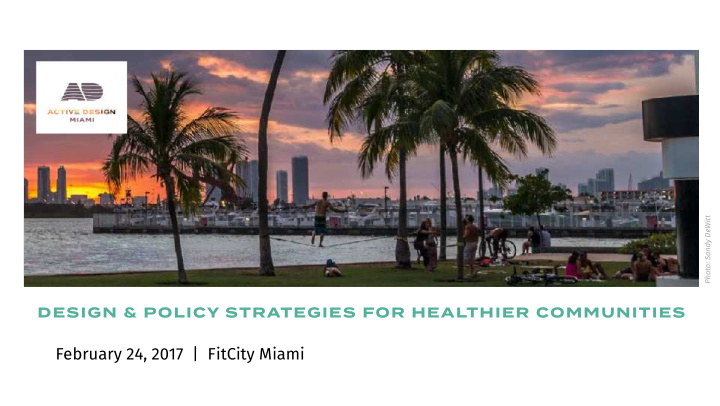



Photo: Sandy DeWitt DESIGN & POLICY STRATEGIES FOR HEALTHIER COMMUNITIES February 24, 2017 | FitCity Miami
WHAT IS ACTIVE DESIGN? Evidence-based design & policy • strategies to support health Concept originated with NYC’s Active • Design Guidelines Photo: Robin Hill Photography
COLLABORATIVE APPROACH Funded by the Centers for • Disease Control and Prevention Led by MCAD, AIA Miami, and • Photo: Robin Hill Photography Florida Department of Health Guidance from multi- • disciplinary Advisory Council
ACTIVE DESIGN MIAMI • Specifically tailored to Miami-Dade’s unique environment and diverse population • Embraces local initiatives and priorities • Responds to unique opportunities and challenges
WHY ACTIVE DESIGN MATTERS • The built environment influences our behavior—and our health • Design is an indispensable tool for shaping healthier communities Photo: Robin Hill Photography
WHY ACTIVE DESIGN MATTERS • 36% of Miami-Dade High Schoolers engage in regular physical activity. • 1/3 of Miami-Dade adults are sedentary. • 2/3 of Miami-Dade Seniors were treated for hypertension in 2014. Access through: Miami-Dade Matters, Measurement period 2015, update July 2016
WHY ACTIVE DESIGN MATTERS • 28% of Miami Dade Seniors were treated for depression in 2014. • 77% of Miami-Dade worker >16 drive to work, with an average commute of 30 minutes. • 48.6% drive alone for more than 30 minutes. Access through: Miami-Dade Matters, Measurement period 2015, update July 2016
PHYSICAL ACTIVITY & SOCIAL SUPPORT Parks “directly promote physical activity, and indirectly mitigate stress via the spaces’ positive impact on social support.” Y. Fan, KV Das, Q. Chen (2011), “Neighborhood green, social support, physical activity, and stress: assessing the cumulative impact.” Health & Place , Nov;17(6):1202-11.
PHYSICAL ACTIVITY & SOCIAL SUPPORT Dog walkers who perceived greater social support, . . . and who had access to a dog- supportive park within their neighborhood, were more likely to regularly walk with their dog, even after adjustment for other well- known correlates of physical activity. Hayley Christian (nee Cutt), Billie Giles-Corti, Matthew Knuiman, (2010) “’I’m Just a’-Walking the Dog’: Correlates of Regular Dog Walking,” Family & Community Health, 33(1)JanMar:44-52.
PHYSICAL ACTIVITY & SOCIAL SUPPORT Children living near “esthetically pleasing” parks with few team sports installations that emphasize unstructured activities reported: more 15-minute bouts of physical activity ▪ per week, greater variety of physical activity, and ▪ had less percentage of truncal fat. ▪ Madeleine Bird, Geetanjali D. Datta, Andraea van Hulst, Marie-Soleil Cloutier, Mélanie Henderson, Tracie A. Barnett, “A park typology in the QUALITY cohort: Implications for physical activity and truncal fat among youth at risk of obesity, Preventive Medicine , Vol.90, September 2016:133–138.
PHYSICAL ACTIVITY & SOCIAL SUPPORT An urban greenway trail designed to enhance connectivity of pedestrian infrastructure with nearby retail establishments and schools, showed significant changes between the experimental and control neighborhoods for total physical activity and cycling . Eugene C. Fitzhugh, David R. Bassett Jr., Mary F. Evans (2010). .”Urban trails and physical activity: a natural experiment.” American Journal of Preventive Medicine . 39 (3).
GUIDING PRINCIPLES 1. Physical, mental, and social health are interconnected 2. Safety is a critical priority Photo: James Corner Field Operation 3. Inclusive and equitable design serves everyone 4. Knowledge and information sharing 5. Sustainability is integral
FOUR AREAS OF OPPORTUNITY Parks & Open Spaces Development Patterns Transportation & Mobility Buildings
Photo: Sandy DeWitt SAMPLE STRATEGIES Design, Policy, and Programming Solutions
PARKS & OPEN SPACES
SAMPLE STRATEGIES • Be inclusive—accommodate all ages and abilities • Incorporate amenities to support user comfort—lighting, shade, water fountains, seating • Facilitate waterfront activation through design guidelines and codes • Respond to local needs and cultural preferences Photo: Isabella Bru
DEVELOPMENT PATTERNS
SAMPLE STRATEGIES • Support a diverse mix of land uses • Provide transit-oriented development at appropriate densities • Emphasize pedestrian connectivity Left: Irvans Augustin
TRANSPORTATION & MOBILITY
SAMPLE STRATEGIES • Implement Complete Streets policies • Prioritize the pedestrian experience—wide sidewalks, safe crosswalks, shade, seating, visual interest • Install temporary demonstration projects to raise awareness, measure impacts, and gather community input Ryan Holloway, Armando Rodriguez, and Bobbie Crichton Photo: Miami-Dade Transportation and Public Works -
BUILDINGS
SAMPLE STRATEGIES • Celebrate stairs—visibility, accessibility, aesthetic appeal • Install signs that encourage healthy behaviors • Facilitate on-site physical activity—exercise facilities, gardens, showers • Enhance access to healthy food and drinking water Photo: Michael Moran | OTTO
HOW TO USE THESE STRATEGIES Inform specific design projects • Shape local policies and plans • Support thought leadership • Inspire community action • Photo: Maggie Fernandez
ACTIVE DESIGN MIAMI IS FOR EVERYONE! Not one size fits all • Use the strategies that best fit your • needs and your community’s priorities Photo: Urban Paradise Guild | Debbie Skaggs
Photo: Sandy DeWitt This presentation was supported by the Grant or Cooperative Agreement Number, 1U58DP005957-01, funded by the Centers for Disease Control and Prevention. Its contents are solely the responsibility of the authors and do not necessarily represent the official views of the Centers for Disease Control and Prevention or the Department of Health and Human Services.
Photo: Sandy DeWitt THANK YOU! Download full publication at activedesignmiami.org
Recommend
More recommend